Showing top 0 results 0 results found
Showing top 0 results 0 results found
How to Boost Customer Engagement Using Conversational AI

Research by Oracle suggests that 82% of consumers would switch a brand if unsatisfied with their customer service department. Therefore, a top-notch customer experience (CX) is a must.
Part of the customer experience is conversations you’d have as a brand with your customers, broadly defined as customer engagement. Meaningful interaction improves customer loyalty advocacy, leading to improved revenue. One aspect of enhancing conversations involves using conversational AI.
Would you like to improve your customer engagement?
What is conversational AI software?
Conversational AI includes chatbots and voice assistants that converse with consumers. Chatbots use multiple technologies like big data, machine learning, Natural Language Processing, and many others to mimic human interactions.
Conversational AI can respond to a human question in multiple steps:
- Converts a user's voice into text using Automatic Speech Recognition (ASR).
- Interprets the text leveraging Natural Language Processing (NLP) or Natural Language Understanding (NLU).
- Searches for the most relevant response given the current conditions by executing a big data query.
- Responds using Text-to-Speech (TTS) with voice synthesis or simply a query string run from the big data.
In the mix, you have Machine Learning, where the bot "learns" and improves with time. The app’s algorithm uses human interactions to enhance itself with more use and data (think of the Amazon Echo bot, Alexa).
Let's explore using this technology to boost chatbot engagement and enhance the customer experience.
5 smart ways to improve your customer engagement with conversational AI
1. Leverage hyper-personalization
A Salesforce report suggests that 52% of customers want more personalized interactions. This means you'd want to address them with their names, know their product preferences, figure out their location (country, province, etc.), and quickly access their purchasing history. This makes for a valuable customer asset to drive personalization.
Conversational AI taps into personalization by integrating Customer Relationship Management (CRM) and Inventory Management System (IMS). For instance, if the customer is about to purchase on their birthday, offering them birthday wishes would delight them.
Having conversational AI allows for quickly looking into these parameters to adopt a tailored approach. Also, you can hold two-way dialogues with your customers and learn more about their needs, wants, and even the flaws in your business offerings. You can leverage its multilingual support, which is highly useful for making inroads into the market, and increase brand recognition among clients who speak a particular language by providing a chatbot programmed in their native language.
For instance, conversational AI can identify if the customer is male or female with gender identification in place. It can help tailor responses to a specific gender. Also, when a loyal, high-profile customer approaches your business for a service, conversational AI can look into their phone numbers and associated orders, identify CLV, and assign that particular ticket as top priority to be sent straight to the senior professional.
One such conversational AI example is Pepsodent's Digidentist. It offers personalized oral care experts who help deal with dental issues like tooth pain, decay, sensitivity, etc. It can even redirect users to free online resources to address oral health concerns and get personalized dental guidance.
2. Showcase 24/7 availability
Cultivating the customer-first philosophy requires your business to be there for them — 24/7, 365 days. Offering round-the-clock support to stay competitive and drive customer engagement requires hiring customer service executives in shifts, a rather costly affair.
Instead, adopting conversational solutions using a chatbot builder can help trim customer service expenses by 30% while maintaining consistent customer engagement.
Conversational AI can address common queries, freeing human agents to focus on customized support using customer support tools, which offers cross-functional collaboration to resolve complex customer queries. On the other hand, 24/7 conversational AI can navigate the existing database to provide answers to FAQs and ensure easy self-help by providing links to knowledge base articles.
3. Adopt a proactive approach to customer support
Solving customer issues before they arise is a powerful strategy to drive customer engagement.
Using conversational AI for proactive customer support involves foreseeing potential issues in the planning phase. Also, it is a great way to let customers know you are there for them.
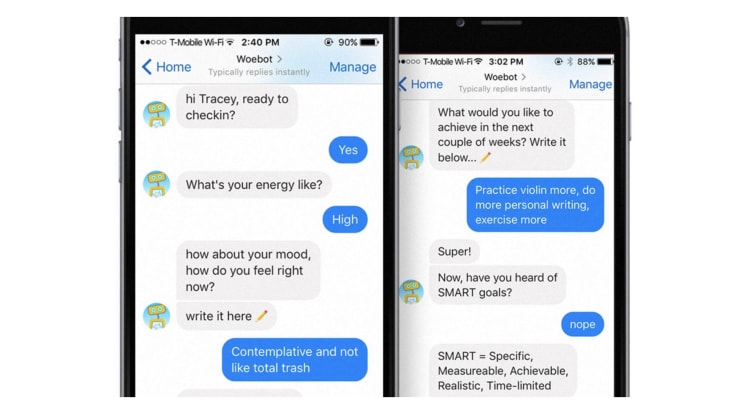
For instance, if your product has a well-known bug and there is a quicker turnaround through self-help, AI bots can route customers there before they face such an issue. This relieves the support staff from doing the redundant job, enabling them to participate in meaningful dialogue to lessen the impact of such issues.
Here’s how to adopt this approach:
4. Faster assistance with conversational AI
Engage customers in the live chat with prompt responses. Leverage customer interaction to strengthen ties with them, minimizing their resolution time. AI-powered Business Intelligence can analyze consumer behavior and ticket trends, helping you to track common challenges and make data-driven business decisions, such as how to satisfy demand. This includes offering quick resolutions within the predefined solutions, as shown below.
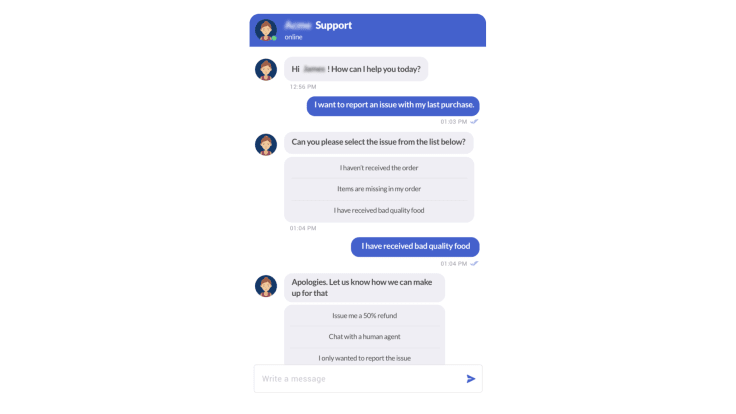
Real-time help
Customers may abandon your services when they do not find the information they need quickly. However, conversational AI can filter out specific issues based on questions and redirect user queries to customer support agents for co-browsing. For instance, if the customer has a query regarding their bill, the chatbot collects consumer data and refers them to a live representative. The agent picks up the chat and uses the co-browsing method to access the customer's bill. They need not ask further questions; agents can direct customers to their website's payment page and modify subscriptions.
5. Understand your customers and improve their experience
HubSpot suggests that 33% of customers don't want to repeat information. Therefore, it's best to filter out information that is already provided by looking into various aspects of customer data, including:
- Age demographics
- Shopping habits
- Geographic locations
- Specific interests
- Spending patterns
Such data helps access your customer's profiles without asking them for the same information. This aids in uncovering opportunities to increase customer engagement.
For example, past purchases can reveal if a client spends more when offered a discount. In this case, integrated chatbots can trigger a discount pop-up message to provide a promotional code (more on this later to promote customer loyalty).
For example, here’s how HelloFresh did it:
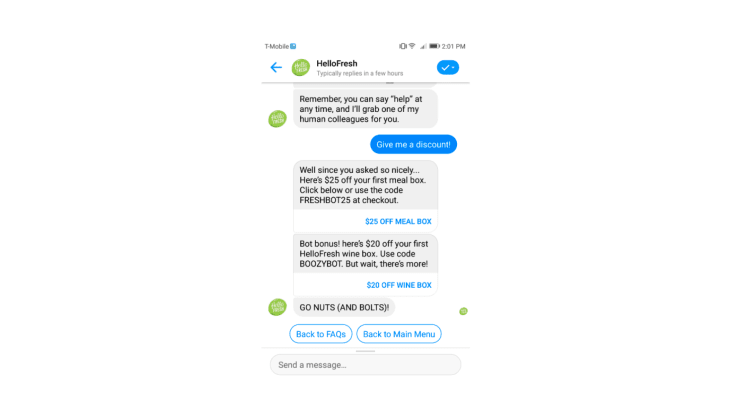
Chatbots can also store information about which discount coupon a customer chooses and what they order. For instance, an ecommerce business can leverage a chatbot session where customers inquire about a specific item's availability in a certain size or color. This data is later used to tailor future offerings to match customer preferences.
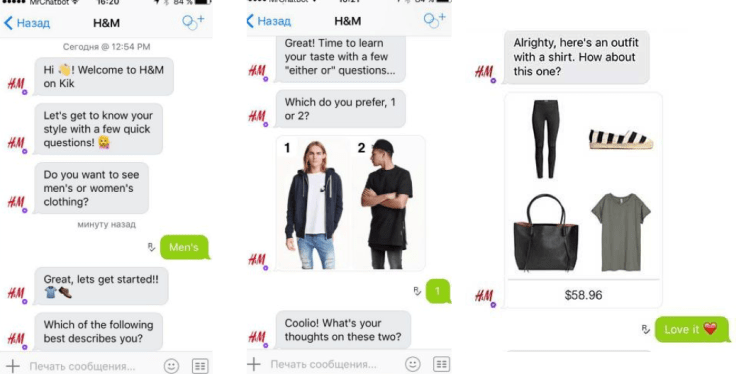
Conversational AI can offer human-like chat by acting as a facilitator, putting customers in the driving seat with leading the questions like:
- "How may I be helpful to you today?"
- “Do you require help?”
- "Do you have other questions?"
- “Can I assist you in finding <what customer is searching for>?"
- "Do you want to check up on the order?"
Your AI bot is doing more than dropping a canned response when a customer responds.
The action consists of the chatbot interpreting the response (using NLP) and finding a relevant question to funnel its response.
This includes narrowing down customer queries:
- “Can you share your order number?”
- “What was your mode of payment?”
- “Kindly share your contact details.”
Answers to such questions help confirm the customer's identity and fetch more details to address their concerns.
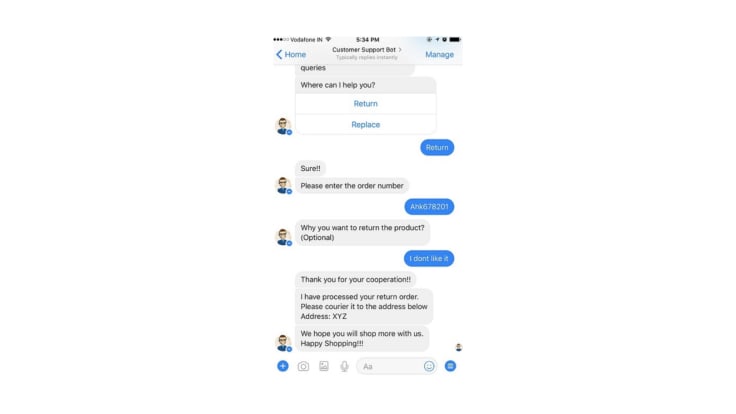
Your conversational AI chatbot has a natural conversation as if they are conversing with an agent over a chat. Research suggests that around 27% of customers who interacted with chat service for customer support had no idea whether they were talking to a bot or a real person.
You can also use the chatbot’s data to drive loyalty while improving customer engagement.
Here’s how:
As mentioned earlier, bots can send discount coupons when asked or based on demographics. Similarly, they can analyze customers’ previous orders and acknowledge loyalty by sending discount coupons, special offers, and freebies via email and social media. You can also use chatbots to enroll customers into a loyalty program.
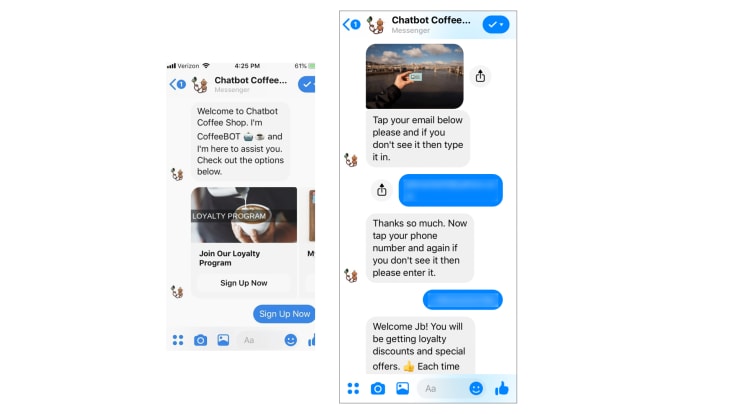
Moreover, the collected information allows you to anticipate customers' demands, learn which features they like, and tailor your offerings accordingly.
Your conversational AI can offer human-like solutions if you can create a "persona” for your conversational AI. They can accurately represent your business’ values and offerings. This involves defining tone, language, emotion, etc. Here’s how to humanize your AI bot.
Would you like to improve your customer engagement?
Over to you
Business automation can improve customer service, and chatbots that work on AI algorithms can drive engagement. Blending both allows you to tackle more complex issues cost-effectively and efficiently. These sophisticated bots have the potential to streamline search processes by answering common user queries and offering solutions — faster and more precisely.
Even more intricately, conversational AI helps identify customer needs, offer recommendations based on their profile, and drive conversions that improve your bottom line.
Conversation AI reduces the need for a human agent for basic, monotonous tasks and helps pivot their expertise to solve sophisticated customer issues. Since chatbots are constantly learning and adapting to user queries, their responses too shall improve over time.



